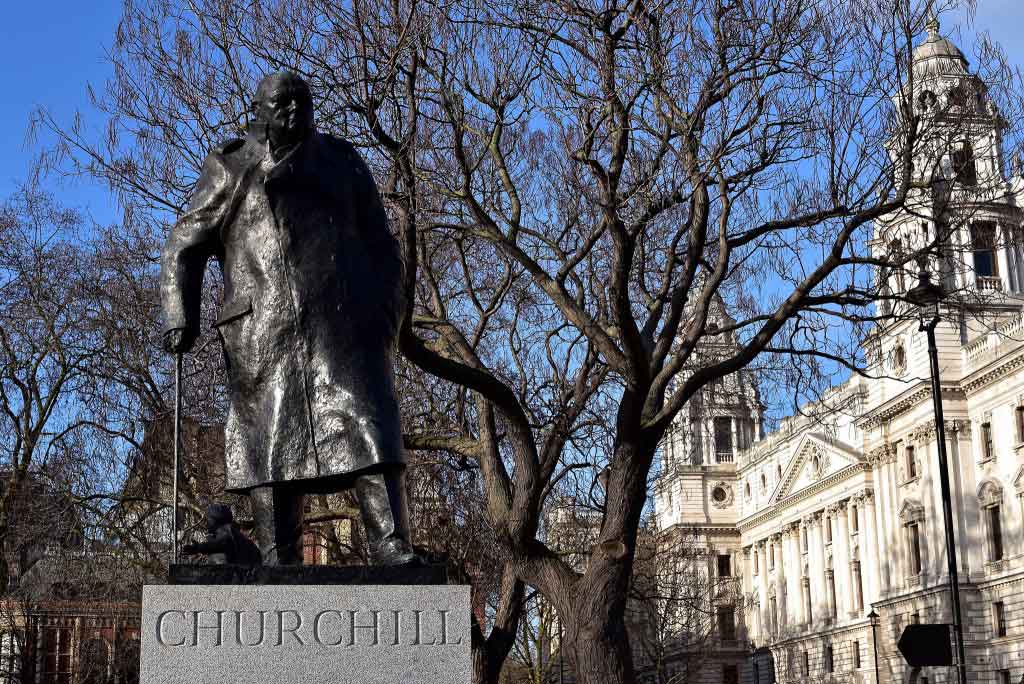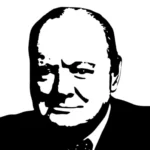
Finest Hour 135
Churchill and the Tank (1): Present at the Creation

Winston Churchill, Parliament Square, London © Sue Lowry & Magellan PR
June 29, 2013
Finest Hour 135, Summer 2007
Page 42
Churchill and the Tank (1): Present at the Creation
By David Fletcher

2025 International Churchill Conference
Mr. Fletcher is author of War Cars (1987) and The British Tank 1915-1919 (2001). Photographs were supplied by the author by kind courtesy of the Tank Museum Collection, Bovington Camp, Dorset.
“In the first place the Commission desire to record their view that it was primarily due to the receptivity, courage and driving force of the Rt. Hon. Winston Spencer Churchill that the general idea of the use of such an instrument of warfare as the ‘Tank’ was converted into a practical shape. Mr. Winston Churchill has very properly taken the view that all his thought and time belonged to the State and that he was not entitled to make any claim for an award, even had he wished to do so. But it seems proper that the above view should be recorded by way of tribute to Mr. Winston Churchill.”
—Royal Commission on Awards to Inventors, in summing up claims in respect of “Invention of Tanks”
The Inspiration/Perspiration Ratio is well known where inventions are concerned, and it should be recognised that Churchill’s contribution falls directly into the former category—but even then it did not spring from nowhere. His duties to the Fleet and the Royal Naval Air Service notwithstanding, the First Lord of the Admiralty was always looking for an opportunity to gain a toehold in a war zone.
It came sooner than he thought when that piratical RNAS officer, Charles Rumney Samson (who in earlier times was one of those who taught Churchill to fly), took his squadron to Dunkirk in 1914. Within weeks, whenever the weather prevented flying, these men were tearing around Flanders in home-made armoured cars, shooting up the German cavalry and having the time of their lives. Grasping the opportunity, Churchill encouraged expansion of this armoured car force with newly made vehicles from Britain and before long anyone with a sense of adventure was anxious to join in; among them the legendary “Bendor,” the Duke of Westminster.
But it didn’t last, and couldn’t last. Trenches appeared, often dug across the roads: barbed wire like-wise. Shell fire began to turn the ground into a quagmire and the movement of armoured cars was restricted. After all, even the best of them were no more than conventional cars with about four tons of armour bolted on, even if many were Rolls-Royces. Most were handed over to the Army while the men dispersed. Some went back to sea. The Duke took his armoured cars to Egypt but others, fired up with the potential of armoured warfare on land, returned to London and thought up new ideas.
Among them was a chap named Tom Hetherington, who somehow managed to retain commissions in the Army and the Navy at the same time. He dreamed up the idea of a huge machine, something one might associate with H. G. Wells, which would roll into Germany on 40-foot-diameter wheels, wade across the Rhine and bring the war to an end in weeks.
Hetherington and Churchill came together at a dinner, hosted by Westminster, and there is little doubt that the young officer’s impossible design reignited the First Lord’s interest. Churchill himself was, above all, a realist, who dealt best with what he could see and understand. Commodore Murray Sueter, Director of the Air Department at the Admiralty, remembers Churchill storming around his office saying, “We must crush the trenches, D.A.D.: It is the only way; it must be done.”1
Churchill’s first effort along these lines was abortive. Two municipal steam rollers were acquired, linked up side by side and then driven like mad at a trench parapet, only to get stuck in the soft mud and sit there, belching smoke, rollers spinning, going nowhere.
On a more practical level the First Lord ordained an Admiralty Landships Committee,2 which met (for the first time in the First Lord’s rooms at the Admiralty since he had the flu) under the chairmanship of Eustace Tennyson D’Eyncourt, Director of Naval Construction, in February 1915. This committee, and the driving force behind it, was Churchill’s greatest contribution to the evolution of the tank.
The Landships Committee’s first problem was to decide upon the respective merits of wheels or Caterpillar tracks. Hetherington’s huge wheeled design was simply too big, and even a half-scale version, designed by William Foster and Company in Lincoln, was rejected at an early stage. That left tracks. But tracks, as a means of crossing rough ground, were hardly known in Britain and early prototypes mostly had to be imported from the USA. Murray Sueter educated Churchill on the properties of tracks by inviting him down to Horse Guards to push a small tracked truck around. Soon the Landships Committee had experiments going on everywhere and Churchill attended one with Lloyd George, as the following article notes, at a testing ground near Wormwood Scrubs.
Even so, Churchill was better with men than machines. and his last great contribution to this saga was to appoint a pushy young merchant banker, one Albert Stern, as secretary to D’Eyncourt’s Committee. Commissioned as a Lieutenant in the RNAS, Stern went at it like mad, with no respect for rank or station. Stern didn’t tread on toes—he leapt on them, and managed to make himself very unpopular. But he got things done. A prototype machine, first known as “Little Willie,” was running by the summer of 1915. Its successor—“Big Willie” or “Mother”—the true prototype of all British World War I tanks—was completed the following December and a matter of months later, production began. As Marcus Frost relates next, tanks went into action for the first time on 15 September 1916. In the circumstances, it was an amazing feat to imagine, invent, design and produce a brand new weapons system in so short a time.
Churchill, by then, was out of the picture. Reaction to the Dardanelles reverse, his resignation from the government and subsequent return to uniform, kept him away from developments in Britain. Yet it did not leave his mind, and from the trenches he sent Sir John French a document entitled “Variants of the Offensive,”3 which proved to be very influential. It was not simply a plea for the tank, but a broad-based look at the problem and various solutions. Try something, try anything! was its basic cry. Even so, Churchill devoted a good deal of the manuscript to “Caterpillars,” as most people called them at the time. In the document he revealed to French that such machines were already being built in Britain and would soon be ready for service—jumping the gun a bit since Fosters of Lincoln were still playing around with the prototype.
What makes this appeal interesting is the fact that Churchill, now that he was an Army officer, was soliciting the Commander-in-Chief’s support. Months earlier he got very upset when one of the Landships Committee revealed the project to General Smith-Dorrien since, at that time, the First Lord wished his Landships to be a naval responsibility.
Douglas Haig saw Churchill’s paper when he replaced Lord French as commander of the British Expeditionary Force in December 1915. A far more responsive officer, despite his undeserved reputation as an unimaginative “blunderer and butcher,” Haig sent one of his officers to see Churchill and then proceeded to England to witness a prototype demonstration. This officer, Colonel Hugh Elles, Royal Engineers, would take command of the Tank Corps for the duration of the war.
Churchill missed the first demonstration of a tank, which took place in the grounds of Hatfield Park, Hertfordshire at the end of January 1916; he was in France. He also missed the second demonstration on February 2nd, which was laid on especially for the Minister of War, Lord Kitchener, but at least Churchill was spared hearing Kitchener refer disparagingly to a “pretty mechanical toy” as he strode off, halfway through the performance.
Churchill returned to the government fold in the summer of 1917, as Minister of Munitions under Lloyd George. By this time the tank programme was in full swing and there was no need for him to become involved. In any case there was more than enough to do; the supply of steel alone was getting beyond the critical state and, with the United States as the main source, there was conflict with the French.
That first tank attack was not a great success, but at least it was sufficient to convince Field Marshal Haig of the tank’s efficacy and cause him to order 1000 more. Basking in a certain amount of reflected glory, Churchill wrote a paper on “The Greater Application of Mechanical Power to the Prosecution of an Offensive on Land,” at the behest of the Prime Minister, for the Committee of Imperial Defence and the War Cabinet.
As Mr. Frost explains, 1917 was a bad year for tanks, notably during the summer offensive when they often floundered in the Flanders mud. Thus it is interesting to note that in a memo to the War Cabinet on the munitions programme for 1918, written in October 1917, Churchill places tanks fifth in a list of six desirable factors, with artillery at the top and even transportation (road and rail) above tanks. The irony is that just a month later, on 20 November 1917 at Cambrai, the tanks turned in a performance that changed virtually every mind.
Not that it was all plain sailing at home. In his new position, Churchill came under increasing pressure, particularly from senior officers, to get rid of Stern, who had trodden on far too many toes. In an acrimonious interview in August 1917, a transcript of which has survived, Churchill gave Stern the dressing down of his life. Stern stood accused of wasting public money on useless tanks, of failing to anticipate future requirements and technical developments and failing to create an experimental department to work on new tanks.
None of this really stands up to close investigation, but Churchill’s anger matched the mood of the time and it was enough to see Stern kicked out of his post, albeit with the promise of a knighthood and a new position as chairman of an Anglo-American tank committee. Churchill’s demand for an experimental department seems to have sparked new thoughts and, about a month later, in a paper entitled “Special Tanks,” he suggested amphibious and mine-clearing tanks. This reveals remarkable prescience, and work on such projects was actually in progress when the war came to an end. It came into its own twenty-seven years later when adapted tanks, referred to as “specialised armour,” cleared the way off the Normandy beaches.
Tanks made a major contribution to British success in the Great War, more than justifying Winston Churchill’s initial leap of faith. Yet that was not the end of Churchill’s association with tanks. As Chancellor of the Exchequer in the interwar years, Churchill made a point of being photographed at significant demonstrations and, of course, his involvement in World War II resulted in the famous Churchill Tank; but that is another story.
Endnotes
1. Broad, Lewis, Winston Churchill (London: Hutchinson, 1941), 163.
2. Churchill, Winston, The World Crisis, vol. 2, 1915 (London: Thornton Butterworth, 1923), 77.
3. Ibid., 86.
4. Churchill, Winston, The World Crisis, vol. 3, part II, 1916-1918 (London: Thornton Butterworth, 1927), 302.
See also Glanfield, John, The Devil’s Chariots (London: Sutton Publishing, 2001); Fletcher, David, War Cars (London: HMSO, 1987; and The British Tank 1915-1919 (London: Crowood Press 2001).
Subscribe
WANT MORE?
Get the Churchill Bulletin delivered to your inbox once a month.



